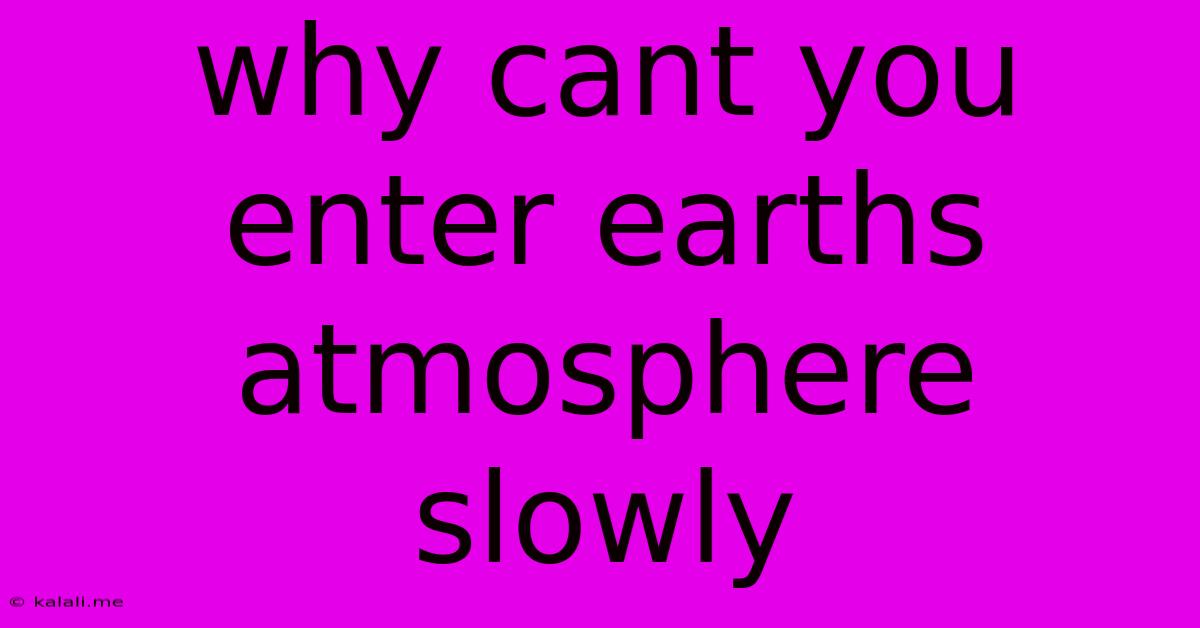Why Cant You Enter Earths Atmosphere Slowly
Kalali
Jun 07, 2025 · 3 min read

Table of Contents
Why You Can't Enter Earth's Atmosphere Slowly: A Deep Dive into Atmospheric Re-entry
Entering Earth's atmosphere slowly is not possible, and attempting to do so would be disastrous. This isn't just a matter of taking longer; it's a fundamental consequence of physics and the properties of our atmosphere. This article will explore the reasons why a slow atmospheric entry is impossible, focusing on the forces at play and the challenges faced by spacecraft and other objects attempting to return to Earth. Understanding this is key to appreciating the engineering marvels behind successful re-entry.
The Problem of Friction and Heat: The primary reason you can't enter the atmosphere slowly is the immense friction generated by moving through the air. As an object moves through the atmosphere, it collides with air molecules. The faster the object moves, the more frequent and energetic these collisions become. This friction converts the object's kinetic energy into heat. The faster the speed, the more heat is generated.
-
High-Speed Re-entry: Spacecraft returning from orbit typically enter the atmosphere at speeds exceeding 17,000 mph (27,000 km/h). At these speeds, the immense friction generates temperatures exceeding 3,000°F (1,650°C) – hot enough to melt most materials. Specialized heat shields, made from materials like ablative composites, are crucial for protecting the spacecraft and its payload.
-
Slow Re-entry's Impossible Heat Shield: Imagine trying to reduce that speed significantly. While the peak temperature might be lower, the total heat generated would be significantly higher. This is because the object spends more time in the atmosphere, constantly experiencing friction. This prolonged exposure necessitates an impractically massive and heavy heat shield, making a slow re-entry entirely infeasible. The weight of such a heat shield would greatly increase the fuel requirements for launch, making the entire mission economically and logistically unsustainable.
Atmospheric Density and Drag: Atmospheric density increases as you descend. A slower descent means the object spends more time in the denser, lower layers of the atmosphere. This leads to increased drag, further slowing the spacecraft and generating additional heat. The balance between atmospheric drag and spacecraft velocity is crucial for a controlled descent; a slow descent exacerbates the challenges of managing this interaction.
Maintaining Control and Stability: Controlling an object's trajectory during atmospheric re-entry is already a delicate process. A slow descent increases the time over which atmospheric forces act on the object, making control even more difficult. This increased time also means that small errors in trajectory correction can accumulate into significant deviations.
Beyond Spacecraft: Meteors and Other Objects
The same principles apply to meteors. Smaller meteors often burn up completely in the atmosphere due to the intense heat generated during entry. Larger meteors, however, might survive the initial fiery descent, but their speed still plays a crucial role in their survival and trajectory. A significantly slower entry would still generate substantial heat and increase the chances of disintegration.
Conclusion:
In conclusion, a slow entry into Earth's atmosphere is physically impossible for practical purposes. The intense friction and heat generated by atmospheric drag at even moderate speeds make it impossible to design a spacecraft or any object capable of withstanding the prolonged exposure required for a gradual descent. The combination of heat, drag, and control challenges necessitates the high-speed, carefully controlled re-entry procedures currently utilized.
Latest Posts
Latest Posts
-
How To Open Steam Controller Menu
Jun 07, 2025
-
How To Build An Interior Wall
Jun 07, 2025
-
Stop Pretending You Cant See Me
Jun 07, 2025
-
Water In Toilet Bowl Wont Go Down
Jun 07, 2025
-
How To Know When Pasta Is Ready
Jun 07, 2025
Related Post
Thank you for visiting our website which covers about Why Cant You Enter Earths Atmosphere Slowly . We hope the information provided has been useful to you. Feel free to contact us if you have any questions or need further assistance. See you next time and don't miss to bookmark.